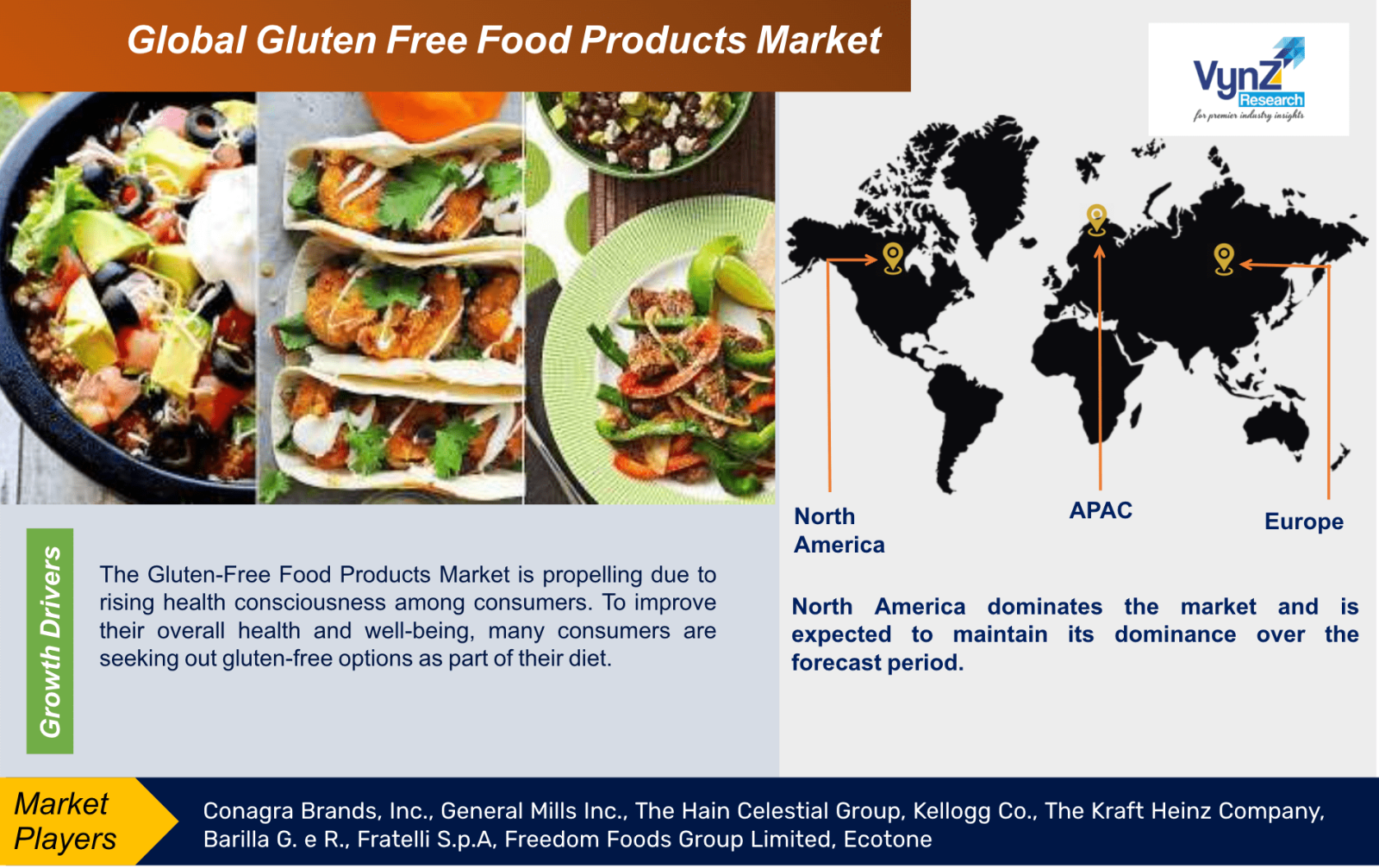| Status : Published | Published On : Sep, 2024 | Report Code : VRFB11026 | Industry : Food & Beverage | Available Format :

|
Page : 198 |

Global Gluten Free Food Products Market – Analysis and Forecast (2025-2030)
Industry Insights By Type (Bakery Products, Condiments and Dressings, Pizzas and Pastas, Snacks and RTE Products and Other Types), By Form (Solid Form and Liquid Form), By Distribution Channel (Speciality Stores, Conventional Stores and Drug Stores & Pharmacies) and By Geography (North America, Europe, Asia-Pacific, South America and Middle East and Africa)
Industry Overview
The Global Gluten-Free Food Products Market is projected to grow at a CAGR of 8.5% from USD 7.8 billion in 2023 to USD 13.6 billion in 2030 during the forecast period from 2025 to 2030.

The products which do not contain gluten are Gluten-free food products such as a protein found in barley, rye, wheat and related grains. These products are particularly manufactured and processed to eliminate gluten which makes them suitable for individuals with gluten-related disorders like celiac disease, non-celiac gluten sensitivity and wheat allergy. Today’s unhealthy lifestyles and the rising popularity of celiac diseases is expected to drive product demand. Also prevention of health disorders like diabetes, obesity, heart disease, chronic pulmonary disease along with metabolic syndrome, is anticipated to drive market growth. The consumption of gluten-free products increased highly during the COVID-19 pandemic. Hence, consumer interest in the nutritional functioning of foods has increased during the pandemic. Consumers’ definition of "healthy" includes their emotional and mental well-being in which food plays an important part in reaching these goals. The closing down of hotels, restaurants and cafés resulted in increased consumption of home-cooked food by the usage of gluten-free products that included cakes, bread and cookies.
Market Segmentation
Insight by Type
- Bakery Products
- Condiments and Dressings
- Pizzas and Pastas
- Snacks & RTE products
- Other Types
On the basis type, the global Gluten-Free Food Products Market is classified into Bakery Products, Condiments and Dressings, Pizzas and Pastas, Snacks and RTE products and Other Types. Among these, the snacks and RTE segment dominate the market as the end users now have become more health conscious by finding new ways to prevent several diseases. Also companies are launching new gluten-free products.
Insight by Form
- Solid Form
- Liquid Form
Based on form, the global Gluten-Free Food Products Market is segregated into Solid Form and Liquid Form. Solid form dominates the Gluten-Free Food Products Market as to cater to the global end user demand manufacturers are into large production of the solid form of gluten-free products.
Insight by Distribution Channel
- Speciality Stores
- Conventional Stores
- Drug Stores & Pharmacies
On the basis of distribution channel, the global Gluten-Free Food Products Market is classified into Speciality Stores, Conventional Stores and Drug Stores & Pharmacies. Speciality Stores segment is further subdivided into Confectionary Stores, Gourmet Stores and Bakery Stores. Conventional Stores is also further sub-divided into Grocery stores, Warehouse clubs, Online retailers and mass merchandisers. The segment Conventional Stores accounted for the highest share in the gluten-free food products market as there are frequent purchasing destinations, stores can be accessed easily and various products are available.
Global Gluten Free Food Products Market Report Coverage
|
Report Metric |
Details |
|
Historical Period |
2018 - 2023 |
|
Base Year Considered |
2024 |
|
Forecast Period |
2025 - 2030 |
|
Market Size in 2024 |
U.S.D. 7.8 Billion |
|
Revenue Forecast in 2030 |
U.S.D. 13.6 Billion |
|
Growth Rate |
8.5% |
|
Segments Covered in the Report |
By Type, By Form and By Distribution Channel |
|
Report Scope |
Market Trends, Drivers, and Restraints; Revenue Estimation and Forecast; Segmentation Analysis; Impact of COVID-19; Companies’ Strategic Developments; Market Share Analysis of Key Players; Company Profiling |
|
Regions Covered in the Report |
North America, Europe, Asia-Pacific, South America and Middle East and Africa |
Industry Dynamics
Growth Drivers
The Gluten-Free Food Products Market is propelling due to rising health consciousness among consumers. To improve their overall health and well-being, many consumers are seeking out gluten-free options as part of their diet. Individuals with gluten-related disorders like celiac disease, non-celiac gluten sensitivity and wheat allergy should strictly hold on to a gluten-free diet to manage their condition. Furthermore, some consumers perceive gluten-free products as healthier alternatives to the traditional gluten-containing foods that drives the demand for these products in the market. Due to some consumers’ existing medical conditions, as well as those who wish to lead a gluten-free life, are becoming the key drivers of market growth as more people try new diets like Keto or the paleo. Now-a-days, consumers are adopting healthier food pattern, they can personalize their shopping experience to fit their unique nutritional demands through technological advancements. Also color-coded shelf tags indicating nutritional properties of certain products, such as gluten-free and heart-healthy have been made available to customers by the retailers. Technology trends including product innovations make these products more delicious. The manufacturing processes include extrusion cooking that helps in increasing the firmness of the product. Pulses have become a major ingredient replacing wheat in gluten-free products as the obese population is increasing which ultimately drives the product demand.
Restraints
The major constraint of the Gluten-Free Food Products Market is the high cost of gluten-free products as the production of gluten-free products involves manufacturing processes and specialized ingredients that result in higher production costs. This can limit the affordability of gluten-free products for some consumers, especially those with lower disposable incomes. Gluten-free products needs to be checked if they truly are free from gluten which requires strict adherence to stringent manufacturing practices and thorough cleaning procedures to prevent cross-contact with gluten-containing ingredients. The availability of truly gluten-free products can be limited and can hamper the expansion of gluten-free market.
Geographic Overview
Geographically, the global Gluten-Free Food Products Market is segmented into North America, Europe, Asia Pacific (APAC), South America and Middle East and Africa. North America dominates the market and is expected to maintain its dominance over the forecast period. Gluten-free foods can lower cholesterol levels, ease digestive ailments and be less fattening. These factors are anticipated to propel the demand over the forecast period.
Competitive Insights
Conagra Brands, Inc. is a consumer packaged goods holding company headquartered in Chicago, Illinois. Conagra makes and sells products in food service establishments, supermarkets and restaurants.
The Hain Celestial Group, Inc. is based in United States which is an international food and personal-care company. Its products include natural foods and organic personal-care items.
Key Players Covered in the Report
The key players of Global Gluten-Free Food Products Market are Conagra Brands, Inc., General Mills Inc., The Hain Celestial Group, Kellogg Co., The Kraft Heinz Company, Barilla G. e R., Fratelli S.p.A, Freedom Foods Group Limited, Ecotone
Recent developments by Key Players
Kraft Heinz is has introduced pancake-inspired IHOP syrups to homes across the country, giving a feel of delicious breakfast at home as dining out. The introduction of IHOP Original and Butter Pecan syrups to grocery shelves all over the countries has brought the flavors from IHOP restaurants to enjoy them with home-cooked breakfast.
English Muffins and bagels in the U.S. has collaborated with WK Kellogg Co to combine the delicious bursts of fruity flavor in Kellogg’s Froot Loops cereal with snack-sized, fan-favorite Thomas Mini Bagels in NEW Thomas’ Froot Loops Mini Bagels.
The global Gluten-Free Food Products Market report offers a comprehensive market segmentation analysis along with the estimation for the forecast period 2025–2030.
Segments Covered in the Report
Region Covered in the Report
- North America
- U.S.
- Canada
- Mexicc
- Europe
- Germany
- U.K.
- France
- Asia-Pacific (APAC)
- China
- Japan
- South Korea
- India
- South America
- Brazil
- Argentina
- Rest of South America
- Middle East and Africa
- Turkey
- UAE
- Saudi Arabia
- South Africa
- Rest of MEA
.png)
Source: VynZ Research
.png)
Source: VynZ Research
Frequently Asked Questions
Purchase Options
Latest Report
Research Methodology
- Desk Research / Pilot Interviews
- Build Market Size Model
- Research and Analysis
- Final Deliverabvle
Connect With Our Sales Team
- Toll-Free: 1 888 253 3960
- Phone: +91 9960 288 381
- Email: enquiry@vynzresearch.com
Gluten Free Food Products Market
